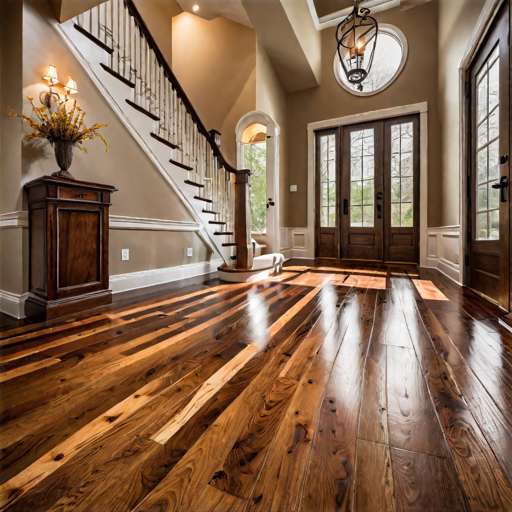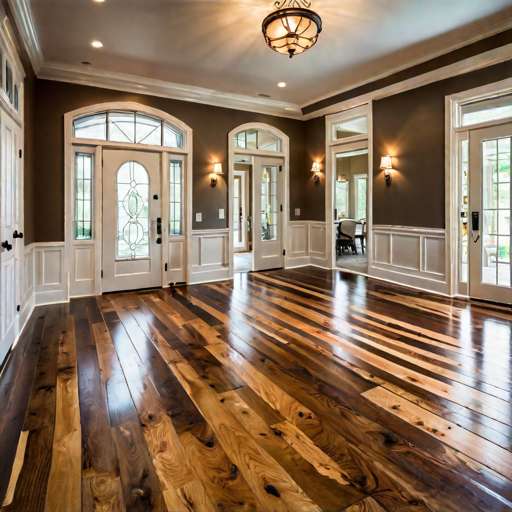Restaining hardwood floors can breathe new life into your home’s interior, transforming dull and worn-out flooring into a stunning focal point. Over time, hardwood floors can become scratched, faded, or discolored, losing their original beauty. However, with the right knowledge and techniques, you can bring back the luster and elegance of your hardwood floors. In this comprehensive guide, we will walk you through the process of restaining your hardwood floors, from preparing the surface to selecting the right stain and applying it evenly. Discover the steps to achieve professional-looking results and enjoy the renewed beauty of your hardwood flooring.
Restaining Hardwood Floors
Restaining hardwood floors is a popular way to give them a fresh, new look. Over time, hardwood floors can become worn and faded, losing their original beauty. By restaining the floors, you can revive their appearance and restore their natural luster.
Before starting the restaining process, it is important to properly prepare the floors. This involves thorough cleaning and sanding to remove any existing finish or imperfections. Once the floors are clean and smooth, you can begin applying the new stain.
When choosing a stain for your hardwood floors, consider the color and tone you want to achieve. There are many different shades and finishes available, so take the time to select the one that best complements your decor and personal style.
Applying the stain requires careful attention to detail. It is important to apply an even coat of stain, working in small sections at a time. Use a brush or cloth to ensure the stain is evenly distributed and penetrate the wood grain.
After applying the stain, allow it to dry completely before applying any sealant or protective finish. This will help to ensure the longevity and durability of the newly stained floors. Once the sealant is dry, you can enjoy the renewed beauty of your hardwood floors.
The Process of Refinishing Hardwood Floors

The first step in refinishing hardwood floors is to sand them down to remove the existing finish and any imperfections. This can be done using a drum sander or a floor buffer with sanding pads. It is important to sand the floors evenly and follow the wood grain to achieve a smooth surface.
After sanding, it is essential to clean the floors thoroughly to remove any dust or debris. This will ensure proper adhesion of the new finish. Once the floors are clean and dry, you can apply the chosen finish, such as polyurethane or varnish.
When applying the finish, it is important to follow the manufacturer’s instructions and work in small sections at a time. Use a brush or roller to apply an even coat, and allow each coat to dry before applying the next. Multiple coats may be necessary to achieve the desired level of protection and sheen.
Once the final coat of finish is dry, it is recommended to wait at least 24 hours before placing furniture or rugs back on the floors. This will allow the finish to fully cure and harden, ensuring its longevity and durability.
Refinishing hardwood floors can significantly enhance the overall appearance of a room and increase the value of your home. It is a worthwhile investment that can breathe new life into tired and worn-out floors.
Tips for Achieving a Beautiful Stain on Hardwood Floors
 When it comes to restaining hardwood floors, there are a few important tips to keep in mind to ensure a beautiful and long-lasting result. First and foremost, preparation is key. Before applying any stain, make sure to thoroughly clean and sand the floors to remove any existing finish or imperfections. This will help the new stain adhere properly and create a smooth surface for an even application.
When it comes to restaining hardwood floors, there are a few important tips to keep in mind to ensure a beautiful and long-lasting result. First and foremost, preparation is key. Before applying any stain, make sure to thoroughly clean and sand the floors to remove any existing finish or imperfections. This will help the new stain adhere properly and create a smooth surface for an even application.
Once the floors are prepped, it’s time to select the right stain color. Consider the overall style and color scheme of the room when choosing a stain. Lighter stains can create a more open and airy feel, while darker stains can add a touch of elegance and warmth. It’s also important to test the stain on a small, inconspicuous area of the floor to ensure it achieves the desired color.
Choosing the Right Stain Color for Your Hardwood Floors
When it comes to restaining hardwood floors, selecting the perfect stain color can make all the difference in transforming the look and feel of your space. Start by considering the existing color palette of the room and the overall aesthetic you want to achieve. If you’re aiming for a modern and minimalist look, lighter stains such as oak or maple can help create a clean and contemporary feel.
On the other hand, if you prefer a more traditional or rustic look, darker stains like walnut or mahogany can add depth and richness to your hardwood floors. Remember to take into account the natural lighting in the room, as well as the size and layout of the space, as these factors can influence how the stain color appears. By taking the time to carefully select the right stain color, you can enhance the beauty and character of your hardwood floors.
Frequently Asked Questions about Restaining Hardwood Floors
Can I restain my hardwood floors without sanding?
Yes, it is possible to restain hardwood floors without sanding, but it is generally recommended to sand the floors first to ensure proper adhesion and a smooth finish. Sanding helps to remove the existing stain, smooth out any imperfections, and create a clean surface for the new stain to penetrate.
How often should I restain my hardwood floors?
The frequency of restaining hardwood floors depends on various factors such as the type of wood, the amount of foot traffic, and the wear and tear over time. As a general guideline, it is recommended to restain hardwood floors every 5 to 10 years to maintain their appearance and protect the wood.
Restaining Hardwood Floors: A Summary
In conclusion, restaining hardwood floors is a worthwhile endeavor that can transform the look of your home. Whether you want to refresh the appearance of worn-out floors or change the color to match a new design scheme, restaining offers a cost-effective solution. By following the proper preparation and application techniques, you can achieve stunning results. Remember to thoroughly clean and sand the floors before applying the stain, and choose a high-quality stain that complements your desired aesthetic. Additionally, applying a protective finish will help preserve the newly restained floors for years to come. With patience, attention to detail, and the right tools, you can successfully restain your hardwood floors and enjoy a beautiful, revitalized living space.


